 |
|||||||||
Classical Editor: Rob Barnett
Music Webmaster
Len Mullenger:
Len@musicweb-international.com
|
Classical Editor: Rob Barnett
Music Webmaster |
|||||||||||||||||||||||||||||||||||||||||||||
Classical Editor: Rob Barnett, Spoken Word Editor :Gerald Fenech, Reviewers: Rob Barnett, Ian Lace, Len Mullenger, and: Richard Adams, Terry Barfoot, Arthur Butterworth, Paul Conway, Gary Dalkin, Andy Daly, Tony Duggan, Gerald Fenech, Lewis Foreman, David Frieze, Malcolm Galloway, Ian Marchant, Humphrey Smith, Philip Scowcroft, Colin Scott Sutherland, Andrew Seivewright, Richard Whitehouse, Reg Williamson, Peter Grahame Woolf, David Wright. A complete list of contributors can be seen here
March 2000 part 1 |
[Part 1]
[Part 2] [Part 3] [Part 4] [thumbnails] |
For those wishing
to print the reviews there are continuously scrolling texts
without CD cover graphics
here
© Music on the Web(UK) 2000. All rights retained. Reviewers retain
copyright on their reviews.
Disclaimer
George ANTHEIL (1900-1959) Concert Music: Symphony No. 4 ('1942'); Symphony No. 6 McKonkey's Ferry (Washington at Trenton); A Concert Overture Theodore Kuchar conducts the National Symphony Orchestra of Ukraine.
NAXOS 8.559033 [67:43]
Save around 22% with
the retailers listed alongside
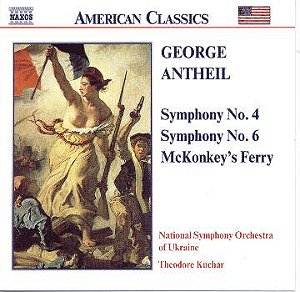
George Antheil is remembered by film music enthusiasts for his scores for such films as The Plainsman (1938); Spectre of the Rose (1946); Knock on any Door (1949); In a Lonely Place (1950); and The Pride and the Passion (1957). He is also famous, or infamous, as the composer of the 1925 Ballet Mécanique composed for an orchestra consisting of percussion instruments, player pianos, electric buzzers, and even an airplane propeller.
George Antheil was born in Trenton, New Jersey. He studied for a while with Ernest Bloch (his studies ended prematurely when his cash ran out) before moving to Paris where he entered a coterie that included James Joyce, Ezra Pound, Ernest Hemingway, Man Ray, Satie, Picasso and many others. His Ballet Mécanique caused one of those Parisian riots that we hear about so often, but it preluded Antheil's withdrawal from things avante garde in favour of more appealing and lucrative work in the musical-theatre and film music communities back home in New York.
In 1940 he became a war correspondent (at other times he had been employed as a lonely-hearts columnist and wrote articles on endocrinology). His Symphony No. 4 was written during this period. Of it he commented that it was - "Written…during a period when the entire future of the world hung in the balance, its first movement undoubtedly reflects my tense and troubled state of mind while writing it: I had no actual program in mind; but every day, I was watching the news, from Stalingrad, from Africa, from the Pacific…the second movement is tragic - news of Lidice and the horrors of Poland had just come in - while the third; the Scherzo is more like a brutal joke of war. The fourth, written after the turn of the tide at Stalingrad and our landings in Morocco, heralds victory.
The first movement is tense and troubled indeed, a powerful astringent and gritty statement heightened by many changes of mood and tempo. At times its many complex strands scream out as a brutal cacophony of war. The second movement has a fearful, nervous lyricism and I was reminded very much in places (as I was to a lesser degree in the opening movement) of the film music of Bernard Herrmann. I wonder if he knew this symphony? This second movement ends on a chill and harrowing note. The Scherzo is cold mechanical and devilish; I was reminded of Vaughan Williams's 4th and 6th symphonies although the overall similarity in this symphony leans more towards Shostakovich and Prokofiev. As Joshua Creek says in his erudite booklet notes, of the closing Allegro non troppo, 'Antheil's work as a film score composer is nowhere more evident than in the fourth movement. One can practically envision it as a soundtrack to a newsreel. Grim march rhythms are juxtaposed with triumphant tuttis. Dozens of tempo changes serve to amplify the episodic effect...'
Antheil's 6th Symphony (premiered in February 1948), was inspired by Eugène Delacroix's painting, 'Liberty Leading the People' (see the cover design of this CD). This is another powerful symphony. A quirky allusion to 'The Battle Cry of Freedom', in the flutes and upper woodwinds, is heard early in the brusque and abrasive first movement, before a rather Prokofievian moto perpetuo theme in scurrying eighth notes is introduced. The second movement is a sombre reflective slow waltz that is rather Satie-like while the Trio sounds vaguely Mahleresque. The concluding, scampering rondo is at least a bit more cheerful and was described by Antheil as '…the triumph of joy and optimism over despair.' Post war blues? But at least there is some jazz and syncopation here to liven things a bit.
Antheil's Concert Overture, McKonkey's Ferry (1948) was inspired by the image of George Washington's crossing of the Delaware on Christmas Night 1776. Again the work's theme is victory and freedom. The music is very evocative of the troops and gun carriages crossing the river. There are telling little vignettes - perhaps a boy soldier proudly playing his piccolo, for instance. But besides the swagger and bravado there is a note or two of anxiety expressed by the strings, and brief tender passages as though the troops might be thinking of home.
Not an easy album for there is much very red meat here, but this is a rewarding experience for the adventurous music lover and the performances are first rate.
Reviewer
Ian Lace

ARNE: ALFRED An English Masque Jennifer Smith, Christine Brandis, David Daniels, Jamie MacDougall, Philharmonis Baroque Orchestra and chorale cond. Nicholas McGegan
Deutsche Harmonia Mundi 75 605 51314 2
Save around 22% with
the retailers listed alongside
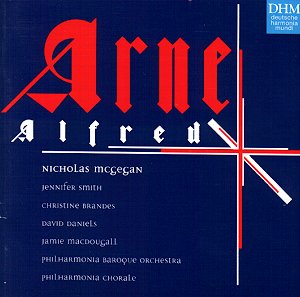
The Masque of Alfred - apart of course from its finale "Rule Britannia" - has in the 1990s reached CD. Just two years ago a version was issued with the BBC Music Magazine and now we have this more complete account (though there were several variants in Arne's own day) from Nicholas McGegan, an experienced exponent of 18th Century music, recorded in America and using mainly American performers. And very welcome is it. If offers 76 minutes of music, 25 minutes more than the BBC CD and if the OAE's playing on the latter under Nicholas Kraemer often seems rather superior, the Philharmonic Baroque Orchestra are fully equal to Arne's demands which include often atmospheric parts for oboes, horns and flute as well as the basic strings. McGegan uses only four solo singers against the BBC's six. Best of them for me is the Scottish tenor Jamie MacDougall, taking both the title role and the less sophisticated one of Corin. Of his two sopranos Jennifer Smith sings Eltruda and Edith, who has just one aria but a memorably touching one, Christine Brandes the shorter breathed, often more "folky" parts of Emma and the Spirit. David Daniels (counter-tenor), the least experienced, maybe of the four copes well enough with Prince Edward. The chorus sing only in "Rule Britannia" and to me this makes less impact than on the BBC disc which uses just the six soloists in chorus. We all know "Rule Britannia", though and one should be grateful to hear so much of Arne's notably tuneful, well crafted music in this valuable, well recorded release. The booklet prints the words in three languages.
Reviewer
Phil Scowcroft

EDGAR BAINTON Symphony No. 2 in D minor HUBERT CLIFFORD Symphony 1940 JOHN GOUGH Serenade for small Orchestra BBCPO/Vernon Handley
CHANDOS CHAN 9757 [73 min]
Save around 22% with
the retailers listed alongside
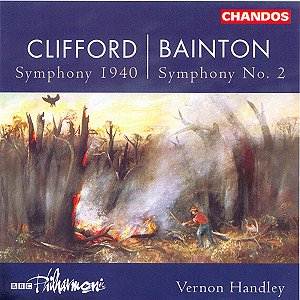
Bainton's Symphony No. 2 in D minor was completed in 1939 in Australia. The piece nevertheless used sketches made in about 1933 when Bainton planned a tone poem based on Swinburne's poem Thalassa. These sketches were taken out in 1939 and expanded into a sizeable multi-sectional work cast in one single movement and roughly adhering to the traditional symphonic model. This fairly impressive, warmly romantic work is nevertheless "an end rather than a beginning" (Lewis Foreman). Bainton's Second Symphony has many powerful moments such as the slow introduction building to a first mighty climax. This is followed by some scherzo-like sections with some heavily pounding bass drum strokes which have a menacing effect that reminds us that the work was completed in 1939. The succeeding slow sections open with a Baxian "shimmering orchestra" (Lewis Foreman) and after reaching some climaxes lead into a fairly impressive, majestic peroration. Though overtly romantic the music at times has echoes of Bax and Moeran. Though no shattering masterpiece Bainton's Second is still a beautiful piece of music, superbly written, that has its impressive moments and that unquestionably deserves more than the occasional hearing. Hubert Clifford's Symphony 1940 completed at about the same time as Bainton's Second is another impressive achievement by a composer whose stature as "serious composer" has still to be re-appraised. This ambitious, though not flawless work has much to commend itself. Its four movements follow the traditional symphonic pattern with a short scherzo placed second followed by a weighty slow movement that really is the heart of the symphony. The first movement, which Clifford described as "epic", opens with much energy and achieves a considerable momentum before ending on "a questioning horn call" which leaves the argument unresolved. The slightly grotesque scherzo that follows somewhat relaxes the tension accumulated in the course of the first movement. As already mentioned the slow movement is the longest and the weightiest as well of the whole work. The pastoral mood of its opening soon gives way to a more elegiac, at times troubled mood building to some tremendous climaxes before calming down to the opening mood. The last movement has the same rhythmic energy as the first movement. Tension builds up again until the final peroration is reached. Then the central theme from the first movement, now given out by trumpets, is superimposed over the end of the symphony "in effect shaking a defiant fist at heaven and would-be oppressors" (Lewis Foreman). Clifford's music has echoes of Walton and Bliss but is still personal enough to retain attention from first to last. No mean achievement indeed by a composer who obviously put much of his most intimate self into this powerfully evocative music. This unusual release is completed by John Gough's short, Delius-like Serenade for Small Orchestra written in 1931 for Hubert Clifford's wedding.
This is the kind of release that should appeal to any member for this is really what the Society is aiming at and looking for, i.e. high quality performances and recordings of unfamiliar byways of the British symphonic tradition to which the Australian-born Hubert Clifford unquestionably belongs.
The BBC Philharmonic marvellously support Vernon Handley's committed readings of these impressive, though long forgotten symphonies. Unreservedly recommended.
Reviewer
Hubert Culot

see also earlier review by Rob Barnett
BARTOK: Duke Bluebeard's Castle Op. 11, Cantata profana Sz 94. Hertha Topper, Dietrich Fischer Dieskau, Helmut Krebs. RIAS Kammerchor, Chor der St. Hedwigs-Kathedrale, Radio-Symphonie-Orchester Berlin Ferenc Fricsay
DG Originals Mono/Stereo 457-756-2 73m ADD (Recorded 1951/58)
Save around 22% with
the retailers listed alongside
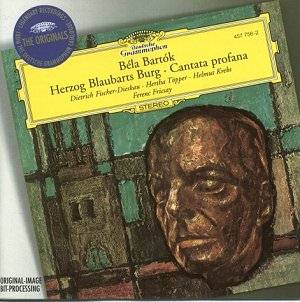
.
Following hot on the heels of an inimitable Kodaly disc this new Bartok/Fricsay offering promises to be a similar authorative issue that confirms the late lamented Hungarian conductor's white-heat conducting of his countrymen's unique music. The brooding 'Duke Bluebeard's Castle' has received a number of excellent recordings, one must recall Decca's classic Kertesz version (another short-lived Hungarian) which has resurfaced in superb sound on the Legends series. Perhaps, the version on offer here may appear to be a non-starter as it is sung in the German language but for me it takes nothing away from a deeply intense and poetical reading that stands aside as one of the supreme examples of Bartokian art. Fischer Dieskau is suitably melancholic as Duke Bluebeard, he eclipses Walter Berry's sturdy yet unimaginative performance for Kertesz with ease. I was also immensely moved by Hertha Topper's Judith who sings her part with inflammatory passion and if not the equal of Christa Ludwig she is certainly a powerful and persuasive advocate on emotional terms. Throughout the dialogues, Fricsay's conducting is like a man possessed, the orchestral playing is utterly magnificent, woodwinds, strings, all departments play with a demonic intensity for the charismatic conductor. It is a version to treasure and with a crystal clear recording refurbished to perfection by DG, this Bluebeard should be the primary recommendation albeit the German connection.
The coupling to this magnificent interpretation is a similarly white-hot interpretation of the 'Cantata Profana'. Although the 1951 recording may be slightly fuzzy and constricted in places there is still a definite stamp of authority on proceedings. Fischer-Dieskau is joined by Helmut Krebs who sings with great ardor throughout. There are also some potent contributions from the two Berlin choirs and the rousy ending makes a convincing end to what is a quite wonderful disc. Libretto and texts are in three languages whilst there is also a poignant photograph of the already frail Fricsay in all his commanding power. No lover of Bartok's music or of modern 20th century classics should be without this exceptional issue.
Reviewer
Gerald Fenech
Performance:

Sound:

Bernstein West Side Story symphonic dances; Gershwin Cuban Overture & Rhapsody in Blue; Grainger Fantasy on Porgy & Bess Jocelyn Abbott & Laura O'Gorman (piano duet)
Cubitt Music ( A Quatre Mains) AOGCD 1. 64' 56"
Save around 22% with
the retailers listed alongside
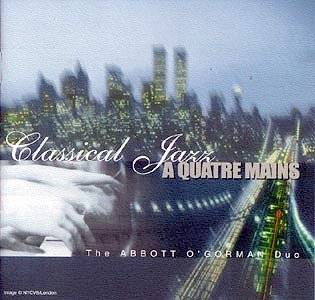
This is one of the finest piano duet (at one piano) CDs I have heard. The pianists' names were new to me, although I learn that they have recorded Ravel for Meridian (CDE84300). Piano duet is a fascinating, under-rated medium, which used to give domestic satisfaction in the days when every house had a piano, and earlier generations learned orchestral music through piano transcriptions, often for four hands. (Mozart and Schubert both produced substantial bodies of music for piano duet.)
These duettists have a flair for bringing out the best from all these well known scores, which emerge amazingly fresh without their orchestral clothes. It is easier at one piano than two to adjust balance and tone and avoid getting too loud, and this duo is as sensitive as you could wish to all the nuances and colours a good Steinway can offer.Great clarity, immaculate pedalling, impeccable recording and stylish presentation, with full notes and several session photos of the Abbott O'Gorman Duo - this one is going to go in many 'best of the month' lists, I am confident. They produced it themselves, from studio to engineering to cover design, production, marketing and distribution; an admirable example of enterprise and determination. Under the "a quatre mains" brand, they plan are to issue other interesting titles, which I await with interest.
Reviewer
Peter Grahame Woolf

SIR ARTHUR BLISS A Knot of Riddles, Angels of the Mind and other songs. Geraldine McGreevy (sop); Toby Spence (ten); Henry Hurford (bar); Kathron Sturrock (pf); Nash Ensemble conducted by Martyn Brabbins
Hyperion CDA 67188/9 (2 CD set) 122' 31"
Save around 22% with
the retailers listed alongside
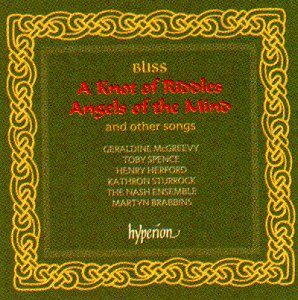
The titling on this handsome boxed set is misleading: for it consists of nothing less than Bliss's complete songs, other than those early ensemble pieces, Rout, Rhapsody, Madam Noy and The Women of Yueh, previously recorded on Hyperion by the Nash Ensemble. This means we now have a couple of dozen early songs, all first recordings, which will come as a revelation if you have only known Bliss's songs from such late settings as the two song cycles on the billing. Indeed this is so pioneering a set, that, with the editor's indulgence, I think we should list them all, so that you can appreciate how indispensable a collection it is for all interested in English song.
CD 1: A Knot of Riddles; Three Romantic Songs (Walter de la Mare); Four Songs; Seven American Poems; Two American Poems; Three Songs by W H Davies; 'Fair is My Love' and 'In Praise of his Daphnis' (from the Serenade); The Tramps; When I Was One and Twenty.
CD 2: Two Nursery Rhymes; Elegiac Sonnet; Angels of the Mind; The Tempest; Ballads of the Four Seasons; The Fallow Deer at the Lonely House; Rich or Poor; A Child's Prayer; Three Jolly Gentlemen; The Hammers; Simples; 'Tis Time I Think by Wenlock Town; At the Window; Auvergnat.
Very few of these have been recorded before, so this is a notably pioneering and worthwhile issue, backed up by the sympathetic erudition of Giles Easterbrook's wide-ranging and informative 16-page booklet essay. As Easterbrook points out, by 1925 Bliss had composed about half his output of songs, and the youthful singers in this fine Hyperion team, Toby Spence and Geraldine McGreevy, respond to the freshness of Bliss's early invention, while the often turbulent piano accompaniments are played with suitable swagger by Kathron Sturrock.
Why has no one recorded the gorgeous cycle The Ballads of the Four Seasons before? This is lovely music which as sung here by Geraldine McGreevy immediately becomes a favourite often to be revisited. Bliss the enfant terrible, as he was widely regarded in the years after the First World War, may particularly be heard in an iconoclastic song such as The Hammers, a boisterous encore setting words by Ralph Hodgson, in which Kathron Sturrock evokes the inexorable rhythmic force of Bliss's imagery: surely memories of the war still overwhelming. Yet otherwise, in his early songs, Bliss is seen as a distinctive voice in a re-emerging English mainstream.
The big curiosity here is the music for The Tempest, written in 1921 for Viola Tree and Louis Calvert's celebrated production at the Aldwych Theatre in February that year, two years before Honegger wrote his prelude La Tempête, both in their day thought arrestingly modern. Here the two male singers take the role of sailors who are drowned by the waves of drumming which provides the accompaniment. This must have been thought startling avant garde in 1921, but for me it raises questions of the work's imagery, for in this storm we surely share Bliss's nightmares of the barrage on the Western Front. Curiously enough the sound on the CD is far more detailed and precise than in the hall, an analytical acoustic which tends to lose that overwhelming build-up of sound that must have been so striking in the theatre. It is still exciting and well worth having, if not for every day.
If the many miscellaneous songs here recorded are a revelation, to have Bliss's big things, the three important cycles A Knot of Riddles, Angels of the Mind and the Seven American Poems so authoritatively done is even more important for Bliss's reputation as a whole, and our assessment of it. Baritone Henry Hurford is eloquent in the shifting but highly emotional sensibilities of the Seven American Poems, written when Bliss was in the throes of deciding what to do on finding himself in the USA in 1940 after the outbreak of war. Here just once or twice I thought the balance over favoured the piano, as for example in the impassioned second song of the Seven American Poems, "Siege". In A Knot of Riddles, Bliss's late cycle for Cheltenham in 1963, written for John Shirley-Quirk, Henry Hurford's splendid articulation is essential in following the words. Here I was particularly struck by the colour and warmth of Bliss's instrumental writing as caught by the artistry of the Nash Ensemble.
I reported on the recording session for these (BMS News 78 p 181), and now, hearing the songs in quick succession on the CD one is impressed both by the quantity and the variety, covering as they do a span of sixty years. A rewarding and largely unsuspected facet of a name more often associated with the orchestra.
Reviewer
Lewis Foreman
SERGEI BORTKIEWICZ (1877-1952) Symphony No. 1 in D Aus Meiner Heimat (1935-36) [36.11] Symphony No. 2 in E flat (1937) [32.10] orchestrated and played on the electronic SYNTHESISER by Daniel Oke
The Bhagwan Thadani Bortkiewicz project. Bortkiewicz Vol. 11 - CD-23 [68.21]
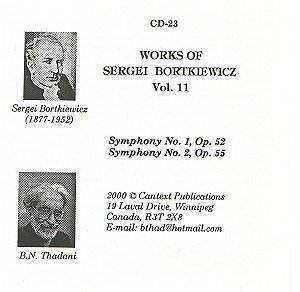
Having traversed the complete piano works of Bortkiewicz, Bhagwan Thadani turns his dedicated attention to the symphonies.
This is the most recent disc in the sequence - only just released. It owes its existence to Malcolm Henbury-Ballan whose vigilance tracked down these otherwise lost scores to the wonderful Free Library at the Fleisher Collection in Philadelphia.
The first symphony declares, through its title, a remembrance of his Russian homeland recalled from the streets and groves of Vienna. The work is fluently Tchaikovskian with much angst and upheaval, flighty comedy and Glazunov-like high jinks in the scherzo. The blindfold test might well place this symphony circa 1900 (if not earlier). Russian Orthodox chant broods gloweringly through the Adagio.
You might from the title have expected music which is relaxed and nostalgic. In fact while this is assuredly nostalgic stuff the edges are unsoftened, the drama is vivid and built by a musician whose reverence for Tchaikovsky is clear. The title may prepare you for the pictorialism of Raff; the music is quite other and the template is Tchaikovsky's Fourth Symphony. I can't wait to hear this with a real orchestra.
Tchaikovsky again is your guide through the second symphony which is even more urgently impassioned than its predecessor. It is often exciting, drawing on the wellsprings of Tchaikovsky (Symphonies 4-5 and Francesca). It is no pallid facsimile but sullen and angry. The andante sostenuto is akin to the final movement of Tchaikovsky 6 and builds a lapel-gripping atmosphere. The finale sustains the excitement but its angst reacts with the same impulsive Borodin-like music as appears in the finale of No. 1.
I had thought beforehand that with knowledge of the Second and Third piano concertos these works would be closer to Rachmaninov. In fact there is no doubting their allegiance to Great Peter. Both symphonies are throwbacks forty or fifty years linguistically speaking but this does not matter in the slightest.
There is no denying the intrinsically second or third best nature of synthesised orchestral sound. That is not Mr Oke's fault. It is to his credit that so much life and ripeness rises from this synthetic soundscape. When they are recorded (as assuredly they will when ASV or Hyperion hear this) I hope that the fervour captured by Oke will still rise like fumes as it does from these created performances. It will be more than a pity if we get time-serving routine. I can imagine in my pipe dreams what Mravinsky and the Leningrad PO would have done with these symphonies.
I hope you will try this disc. It is an ersatz or substitute for the real thing but then so is any recording.
The music speaks with the accent and confident stride of a master. Doubters should try the last five minutes of the finale of No. 2.
Recommended for enthusiasts, libraries and new repertoire scouts out to tap into the bottomless market for a second Tchaikovsky.
Reviewer
Rob Barnett
PERFORMANCE and MUSIC:

SOUND: synthesiser - special category
See also special article on Bortkiewicz
The disc can be ordered from Mr Thadani at Cantext Publications, 19 Laval Drive, Winnipeg, Canada R3T 2X3. e-mail: bthadani@hotmail.com
BRUCH: Symphony No. 2 op. 36. Concerto No. 3 for Violin and Orchestra. Andreas Krecher: violin. Wuppertal Symphony Orchestra Gernot Schmalfuss
MDG Gold MDG335 0868-2 76m DDD.
Save around 22% with
the retailers listed alongside
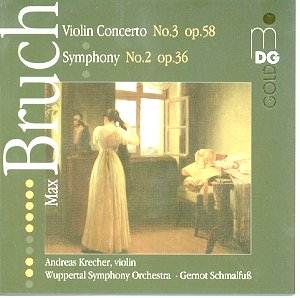
Max Bruch's eminently listenable music is enjoying something of a renaissance lately with many releases of his symphonies, particularly on Chandos and MDG. This cleanly articulated and well-groomed recording of the beautiful Second Symphony can confidently see off most of the competition. I grew up with these works in Kurt Masur's forceful and eccentrically directed yet brilliant accounts on Philips. Schmalfuss finds infinitely more poetry and essential lyricism in this always romantic wood-glade music. There is particular élan in the sublime Allegro molto tranquillo that slowly builds into a forceful statement from the full orchestra. The same goes for the enchanting Adagio ma non troppo which is permeated with beautiful themes and which is genially and tenderly played by the Wuppertal strings. I also enjoyed Andreas Krecher's rumbustious, poetic account of the Third Concerto, a mammoth piece that definitely deserves the best possible exposure. Shamefully it is not a repertory piece. The expansive Allegro energico includes much that is significant and Krecher's playing matches Accardo's more flamboyant version on Philips (again with Masur). I have not heard Mordkovitch's new account on Chandos (coupled with the 1st Symphony) but this is truly a version to go for. Painstakingly detailed notes and the usual spotlit MDG presentation is an added bonus to these two superbly engineered works. Another winner from Wuppertal!
Reviewer
Gerald Fenech
Performance:

Sound:

BUSONI 24 Preludes Op 37 BLISS Piano Sonata Trevor Barnard (piano )
Pine Art 2.5011 [DDD] [72' 58"].
Save around 22% with
the retailers listed alongside
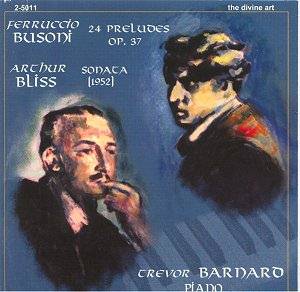
This is an important disc although many will feel the Busoni preludes are both unoriginal and uninspiring. But the Arthur Bliss is very welcome.
I will comment briefly on each of the Busoni preludes.
1 in C. Simple in design, or amateurish, with a wearisome use of pedal notes. Rather immature.
2 in A minor. This has a Spanish or barcarolle flavour. The right hand melody should have been brought out more. It has a curious mixture of style but an agitated middle section with too many trills.
3 in G is an insipid piece and takes a long time to get nowhere.
4 in E minor is a dance movement but rather eccentric. Interesting, nevertheless.
5 in D seems a little out of control at times and stutters badly. Poorly written.
6 in B minor is a chorale with the occasional brave harmony.
7 in A is a gigue and a deliberate imitation of Bach and has a compositional stutter just before the end.
8 in F sharp minor has a wearisome ostinato and lacks originality. You feel you have heard it before.
9 in E. The very beginning of this piece reminds you of a famous piece.
10 in C sharp minor is marked vivace ed energico but it isn't ... and it is rather poor music.
11 in B has a striking resemblance to another piece and is very slight.
12 in G sharp minor is an attractive reverie with a curious Victorian salon atmosphere.
13 in F sharp recalls Schumann and his finger-tripping as in his Arabesque, Op 18.
14 in E flat minor is funereal and takes a while to get going. Its indebtedness to Liszt is obvious.
15 in D flat is a gentle salon piece but of no great impact.
16 in B flat minor is stormy and dark but also stutters. This hesitancy is disconcerting and not having the music in front of me I cannot be sure it is always the way the music is written.
17 in A flat has the same worrying features. As one of my music professors said, "Music with hiccups needs a smooth intake of water."
18 in F minor is rather nondescript.
19 in E flat is the best prelude so far with its slight sparkle.
20 in C minor is rather jumbled and, like number 2, has a left hand which is too dominant.
21 in B flat. As with number 10 this is a very poor piece and mainly note spinning. Terribly unoriginal as proved in the middle section where Bach holds sway.
22 in G minor is a fugue and again Bachian. Having said that, it is a good fugue, as fugues go.
23 in F is very brisk in the main and introduces more eccentricity. Once I thought of Dave Brubeck.
24 in D minor is marked presto but it isn't. It is another piece with little or no substance.
It is good to have this work available. It is of historical interest.
And so to the Arthur Bliss Piano Sonata of 1952 which is vastly superior and has some fascinating forays into 'a modern style'. The slow movement is akin to a soliloquy, although a chaconne, which is a good contrast to a somewhat disappointing first movement. The finale has a stunning start but I am not convinced that the performance is always controlled. I have heard the piece played better. Nonetheless it has to be remembered that it is an exceptionally difficult piece to play ... after all, it is not Mozart or Schubert and I would love to be able to play it.
I am pleased to know that Trevor Barnard's recording of the Bliss Piano Concerto is due for release by Pine Art shortly. This is probably the best British piano concerto in the tonal tradition ... a truly splendid work and I am looking forward to it.
Reviewer
David Wright
Performances

Recording

Frederic DEVREESE Gemini: Orchestral & Piano Works BRTN Philharmonic Orchestra - Brussels, various conductors including the composer Daniel Blumenthal - piano (and Robert Groslot on Gemini: suite for two pianos)
CYPRES CYP1619 [2CDs: disc one - orchestral works: 58:10 / disc two - piano works: 56:19]
Save around 22% with
the retailers listed alongside
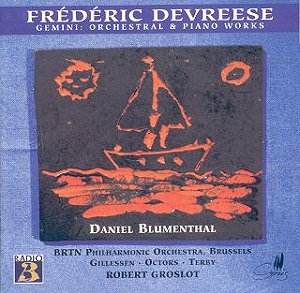
In an episode of the sitcom 'Hippies' one character submitted a review of a new Pink Floyd album to an underground magazine. A 'radical' and somewhat challenging review, it took the form of a child's drawing, complete with a house, stick people and smiling sun. Here the cover, by David Devreese, presumably the composer's son, is in a similar vein; a simple drawing of a sailing boat beneath a smiling sun. Whether this is a positive sign or not is difficult to say, but this 2 CD anthology of music by Belgian composer Frederick Devreese is certainly worth the highest commendation.
In keeping with the title, everything here is twinned. There are two discs, each just under an hour long, the first featuring four orchestral works, the second, four works for piano. Gemini appears on both discs, first as a 'suite for double orchestra', then as a 'suite for two pianos'. There is one mystery: a sticker on the jewel-case bears the legend 'First World Recording', but it is not at all clear whether this refers to certain pieces, or all of them. Printed on the front cover of the booklet is a Radio 3 logo. This is nothing to do with the BBC, but a Belgian classical station of the same name.
When I first pressed play I had something of a shock. Never having heard Devreese before, I had built-up the expectation that this would be 'difficult' music. The opening Overture for Large Orchestra begins with a noble fanfare, leading to playful and eminently melodic music and a regal finale. It reminds me nothing so much as of Ron Goodwin, perhaps the delightful light music of his Drake 400 suite, for, in keeping with the boat on the cover, there is a definite flavour of salt spray. The piece was actually written for King Boudewijn's 25th anniversary party, and the lavishly triumphant climax would not sound out of place in a Hollywood epic. Perhaps this is not surprising, given the royal occasion, and the fact that Devreese has written the music for over 30 films.
The Piano Concerto No.1 is the earliest work here, dating from 1949, and written when the composer was only 20. This is an ambitious and most entertaining work, full of tension and crackling with energy, influences fizzling round the edges. Here is the epic romanticism of Rachmaninov fused with the delicious orchestral jazz of George Gershwin, all delivered with lots of showy fireworks and virtuoso dazzle, yet having enough personality of its own to be thoroughly deserving of attention.
The Valse Sacrée represents the composer's more recent style, offering a lovely flowing melody which leads into the main waltz tune, swirling to a dark and delirious sudden ending. The booklet notes suggest this piece is a synthesis of Devreese's film music style and his dance writing, and I would add that it is not going too far to discern the delirious ghosts of Ravel's La Valse in this incarnadine music. It is, incidentally, the one piece in this collection to be conducted by the composer.
Gemini, of course, must have two incarnations. The suites started out as ballet music. Gemini: Suite for Double Orchestra contains 8 movements and here lasts 23 minutes. The opening has a dream-like atmosphere with chiming bells which call to mind Hovhaness's Symphony No.50 - Mount St. Helen's, before exploding into muscular dance music which encapsulates the jazzy drive of the Big City, and even goes on to have parallels with Dimitri Tiomkin's score for The Thing (From Another World) and Jerry Goldsmith's Alien. Here is music, big, confident, apologising to no one for eclectically fusing the concert hall, jazz orchestra and film score into one vibrant joyously open-hearted celebration. This is exciting, thrilling, exhilarating music packed with larger than life personality. It demands attention.
Gemini: Suite for Two Pianos, in 9 movements lasting 26 minutes, is rather more detached from the original score than is the orchestral suite. While the orchestral version is a colourfully orchestrated battleground, here the two pianists swap roles, alternating lead and accompanying roles, or else mirror one another in various playful ways. The suite begins with bold pulsating, cascading figures, like Michael Nyman on steroids, before taking off in all sorts of exciting an sometimes startling directions.
Lullaby for Jesse is exactly that, while Black and White has the right hand playing the white keys and the left the black. The inPidual pieces are graded for difficulty, the piece originally having an educational role. Masquerade for piano is a virtuoso jazz-inflected work derived from another ballet score. Percussive, dynamic and explosive, it brings the concert to a thoroughly entertaining conclusion.
The Overture and Piano Concerto were recorded live, but the sound quality is uniformly excellent. The playing is very fine, with Daniel Blumenthal delivering some astonishing musicianship in the more demanding music, elsewhere being playful, dramatic, witty or tender with great aplomb. This is not shy music, and requires a confident musician to bring it to life. In Daniel Blumenthal, Frederick Devreese is fortunate to have found a personality sufficient to reflect his own musical image to perfection.
Reviewer
Gary S. Dalkin

ELGAR - The Sketches for Symphony no 3 elaborated by Anthony Payne. Bournemouth Symphony Orchestra/Paul Daniel.
NAXOS 8.554719 [54' 59'']
Save around 22% with
the retailers listed alongside
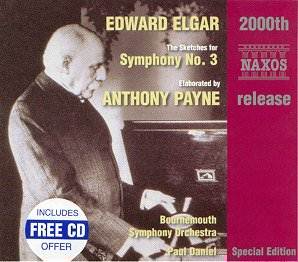
The Andrew Davis/BBC Symphony Orchestra interpretation of the Elgar-Payne Symphony has lodged itself firmly in the public consciousness thanks to a deservedly best-selling CD (NMC D053), an unforgettable world première in a packed Royal Festival Hall and several broadcasts, including a memorable 1998 televised Prom performance. Big-boned, majestic and noble with every detail securely in place, Davis's conception is long-breathed and sure-footed. It has rightly held sway as the definitive reading if the score…until now!
Paul Daniel's new Naxos recording with the Bournemouth Symphony Orchestra is conducted at white heat. Anthony Payne has described completing the sketches as of impelled to do so by forces outside himself and something of that overwhelming compulsion to unlock the agèd Elgar's last blazing vision also informs Daniel's feverish, urgent reading of the score. The Bournemouth orchestra has real bite in its attack and fire in its belly. The very opening bars of the Allegro molto moderato first movement have an edgy quality in the Naxos version: they fairly bristle with nervous energy. Much more than Andrew Davis, Daniel emphasises the contrast between the first subject and the meltingly beautiful cantabile second subject which Daniel imbues with a nostalgic glow (especially on its reappearance in the Recapitulation). The Naxos version includes a spectacular Development section (almost Mahlerian in its anguished outbursts) and there is a blistering, rough-hewn coda: a blaze of glory compared to Davis's stately peroration.
The Intermezzo-like Allegretto second movement also gains from Daniel's quicker tempo: fire and air next to Davies's statelier (and loftier) interpretation. However, in the great Adagio solenne third movement, Davis and the BBCSO plumb searing depths left relatively undisturbed by Daniel and his Bournemouth forces. The spellbinding più lento section which closes the Exposition (starting at bar 62 of the Novello score) unaccountably goes for little in Daniel's hands whereas Davis makes the passage teem with hushed fantasy. Nonetheless, taking the movement as a whole, Daniel does convey a grieving nobility that cannot fail to move the receptive listener.
In the Allegro Finale, the Bournemouth brass tear into the opening fanfare-like call-to-arms and the strings tackle their vigorous arpeggiated figures with fierce determination. The NMC version is more controlled and polished but ultimately less compelling in this movement. One cannot help but feel that for Andrew Davis the emotional climax of the Symphony (and its very heart and soul) is the glorious slow movement whilst Daniel places his interpretative emphasis on the outer movements, seizing upon the chivalric Finale to pick up the driving symphonic argument he underlines so strongly in the opening movement. In the visionary final bars, Daniel leaves the listener with fresh vistas opened up by the magical single tam-tam stroke.
Those who rightly prize their NMC Davis/BBCSO disc will find the new, admirably well-focused Naxos recording complements it perfectly. Davis's version remains ineluctably fine: pure granite set against the Naxos Young Pretender's electrifying force of Nature. The new reading grippingly captures the last flaring up of Elgar's "Spirit of Delight" and for listeners coming to the work for the first time it makes a superb budget-priced introduction to one of the most important British works to enter the mainstream repertoire for decades. Above all, Daniel and the Bournemouth SO make one marvel anew at the sheer bravery of Anthony Payne's undertaking and the raw genius of his (and Elgar's) achievement. Naxos could not have chosen a worthier disc to mark their 2000th release. Highly recommended.
Reviewer
Paul Conway

THE SONGS OF EDWARD ELGAR Catherine Wyn-Rogers (Mezzo-soprano), Neil Mackie (tenor), Christopher Maltman (baritone), Malcolm Martineau (piano)
Somm SOMMCD 220
Save around 22% with
the retailers listed alongside
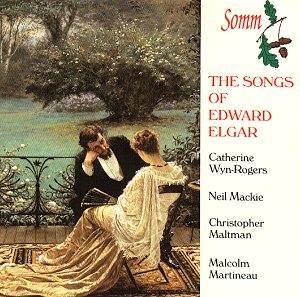
Elgar's songs, generally speaking, are the Cinderella of his oeuvre, as he usually needed a large canvas for the full expression of his musical ideas, yet all of them are thoroughly characteristic and enjoyable. This disc, from the enterprising Somm company, is perhaps the best advocacy they have so for received. All three vocal soloists sing with character and admirable clarity, not least of diction. Perhaps Catherine Wyn-Rogers has the edge but Neil Mackie and the immensely promising Christopher Maltman also contributes splendidly and the fact that the 23 tracks are shared between three different voices help one the more readily to enjoy the whole CD at a sitting. Malcolm Martineau is a sympathetic accompanist; the recording is excellent and the booklet prints all the words.
The basic presentation is chronological, so we began with the early, pre 1900, songs -, Victorian ballads in effect - then pass to the two Benson songs of Opus 41 and to Pleading, an Edwardian ballad, and then to perhaps Elgar's best songs, from around 1910 (Twilight, The Torch, sing with gripping intensity by Mr, Mackie, The River, the tender A Child Asleep etc.). We end with two snippets, sung by Mr. Maltman, Salvaged from Elgar's unfinished opera The Spanish Lady but which drew on early sketch books. Practically all the songs have been recorded previously, though most of them not many times - I had not come across pulsating Arabian Serenade before, nor the vocal setting In Moonlight (with Shelley's words imported thereto; and beautifully phrased by Miss Wyn-Rogers) of the "Canto Popolare" interlude from The South".
Reviewer
Phil Scowcroft

JENNIFER BATE plays British organ music ELGAR AND HIS CONTEMPORARIES Jennifer Bate (organ)
ASV Quicksilva CD ASV 6160
Save around 22% with
the retailers listed alongside
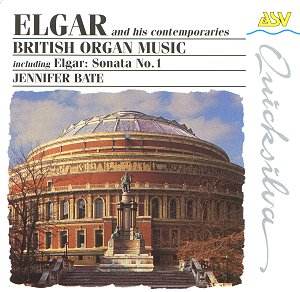
"Jennifer Bate is an excellent organist, not only for her virtuosity, but for her musicianship and sensitivity in choosing her timbre. She loves what she plays and knows how to make others love it too". (Olivier Messiaen)
Given such praise from the 20th century's greatest composer of organ music, Jennifer Bate seems scarcely in need of further bouquets from me, but it is a special pleasure to review her performances of native British composers in contrast to those of Messiaen's inspired outpourings. Not that there is any lack of inspiration in the case of Elgar's Sonata No. l with which the programme opens. It is performed on the organ of the RAH, a sumptuous picture of which adorns the CD cover.
Curiously in 75 minutes of virtually unalloyed enjoyment, my only reservation concerns the first movement which, majestic though it is, lacks clarity in places. After that, all is sweetness and light; glowing and well-integrated colours in the middle movements; jaunty, bandstand articulation in the Finale's 2nd theme, and a thrilling grandstand finish in the last stringendo furlong. Surely Elgar would have approved!
As for the rest, as the Americans so intransitively say, enjoy! I found the soft pieces charmingly portrayed - a Stanford Prelude, Wesley's Holsworthy Church Bells, Rhosymedre, and Solemn Melody. On a larger scale there is Parry's G Minor Fantasia and Fugue and Wesley's Introduction and Fugue. But Elgar has the last word in a stirring Imperial March, which, give or take a largamente or so, could scarcely be bettered.
Organists will revel both in the colourful splendour of the playing, and the three featured instruments, RAH, St. James', Muswell Hill, and St. Andrew's, Plymouth.
It is perhaps of interest here to recall that Ravel described Elgar's music to RVW as 'tout 'a fait Mendelssohn'. Students of British music may be interested to trace the influence of the admired 19th Century European organist-composer in this programme right up to RVW himself.
An enthralling recital persuasively and authoritatively played. Realistic recording. Well judged tempi. What more could you want. Read on!
Reviewer
Andrew Seivewright
and a review of the same disc by Rob Barnett:-
The ELGAR Organ Sonata is a regal (an anagram of Elgar of course) study for a symphony - or so it seems in character. In fact it has been given the symphonic treatment in an orchestration by Gordon Jacob. This was recorded some years ago on EMI and conducted by Richard Hickox, I believe. Of the four movements the subtle allegretto and the leaping final presto are the most immediately affecting. The disc is rounded out and topped off by the blowsy and slightly clouded pomp of ELGAR's Imperial March - better in orchestral garb, I have to say.
S.S. WESLEY's very low profile Holsworthy Church Bells hardly registers at all and by its side the WESLEY Introduction and Fugue is positively imposing. STANFORD's Gibbons prelude and Postlude is followed by the Dvorakian Andante Tranquillo from the same set. The final allegro non troppo is jolly.
WALFORD DAVIES' famous A Solemn Melody (1908) (here in arrangement for organ alone) is suitably meditative. Ms Bate is very good at this mood. Contrast is the keynote of all three of these discs so it comes as no surprise that after the cloisters comes the big and burly PARRY Fantasia and Fugue (1913). VAUGHAN WILLIAMS Rhosymedre is done with all the melodic casualness of Gerald Finzi.
The recording technicalities are well judged and they communicate, apparently unalloyed, Jennifer Bate's sensitive and above all subtle artistry. An attractively priced (bargain range) issue. Long playing time. Good notes by Ms Bate. A well-balanced recital with mix of familiar and unfamiliar.
Reviewer
Rob Barnett

AN IMAGE OF TRUTH The music of DAVID ELLIS Alison Wells, soprano - John Turner, recorder - Joanna Patton, clarinet - Peter Lawson and Keith Swallow, pianos - Jonathan Price, cello - Keith Elcombe, harpsichord - Coull String Quartet William Byrd Singers conducted by Stephen Wilkinson
ASC RECORDS ASC CS CD6
ASC Productions, 145a Chester Road, Macclesfield, Cheshire SK11 8PT
Tel: +44 (0) 1625 423605 Fax +44 (0) 1625 435802
Email:dellismanchester@hotmail.com
Save around 22% with
the retailers listed alongside

Though it was often written on commission and gained its composer quite a number of prizes and awards, David Ellis' music is little-known. The larger audience (including myself) is largely unaware of his music. The present release is thus particularly welcome in that it provides a fine survey of David Ellis' varied output spanning some forty years of composing activity.
The earliest piece is the cycle Dewpoint completed in 1955 to words by Douglas Rawlinson, a friend of the composer. Originally scored for voice and clarinet, harp and strings, it also exists in a chamber version for voice, clarinet and piano recorded here. The overall mood is one of pessimism, maybe the poet's reactions to the war years. Images of darkness with brief flashes of light that nevertheless do not dispel the troubled mood of these songs. Indeed the last song is "an epilogue which promises a dawn without warmth or hope" (David Ellis). In spite of the prevailing mood of these texts, Ellis' music is richly varied and at times warmly lyrical. The music actually transcends the sometimes obscure or enigmatic words of Rawlinson and the result is a very fine work indeed which I would now like to hear in its original scoring.
Completed ten years later the choral Sequentia in Tempore Natali Sancti sets texts taken from the Advent Antiphons interspersed with verses from the well-known carol O My Dear Heart, Young Jesu Sweet. It opens with a setting of the first stanza of the carol sung by a soprano solo. The music then soon gains momentum with rich choral textures which starkly contrast with the comparatively simple refrain (in fact variants of the carol setting). The piece ends with a fuller setting of great beauty of the carol. This is one of the finest works in this collection, a minor masterpiece and a real gem that deserves to be more widely known.
On a smaller scale the delightful Berceuse (1981) for clarinet and piano is yet another fine work that should be better-known and taken-up by clarinetists. Ellis chose "to highlight the clarinet's ability to draw long melodic lines throughout its wide register", and so it does most successfully.
An Image of Truth (1972) is a short piece for soprano, recorder and piano setting a brief text by William Blake. Later it formed the basis of "a much larger choral extravaganza with orchestral accompaniment". The late nineties were obviously very prolific for most pieces in this composer's portrait were written between 1996 and 1998.
The Pertimento Elegiaco (1996) for Baroque trio (i.e. recorder, cello and harpsichord) was written "in memoriam Ida Caroll". It is in three movements: Canticle with tickling ostinato from the harpsichord, pedal from the cello and song-like tune on the recorder. It is followed by a lively scherzo (Impromptu) with a march-like central section and the piece ends with an impressive Chaconne, a serious, deeply moving conclusion to this unusual, though beautiful piece that ends with peacefully tolling bells.
The Second String Quartet also from 1996 is, to me at least, the other gem and a major achievement which repays repeated hearings. again three movements beginning with a Largo ("a solemn procession moving towards a more serene conclusion") followed by a whimsical scherzo with two trios "which parody the styles of a march and a waltz". This too ends peacefully. It leads into the last movement which is a Passacaglia framed by slower introduction and conclusion. This may be the finest work in this collection. (The recording is a BBC production superbly played by the Coull Quartet.)
The song cycle Four Songs (of Hope and Desire) for soprano and piano also dates from 1996. It sets texts by the composer that are "no more than fragments outlining a fantasy-relationship which may have existed in the author's imagination. As in all dreams the incidents jump from bizarre to commonplace without warning or logic". The music is in turn lyrical, at times slightly ironic, sometimes more dramatic or bitter-sweet. A fine piece on all counts.
This compilation also includes two recent pieces dating from 1998 : a short tribute to Sir John Manduell, A Little Cantata for soprano and recorder on a text by the composer and the imposing piano sonata Three-Note Variables. The latter is yet another major achievement. Globally it is a set of variations on a three-note motif heard at the outset. A weighty introduction leads into a dreamy, reflective interlude. This is followed by a massive fugue starting somewhat hesitantly but soon building to a loud climax. It ends abruptly and leads into a Fantasy-Scherzo which is exactly that. The last section Procession with Bells progresses towards an impressive tolling conclusion.
Besides a few shorter pieces the present releases offers a good deal a fine music and some of the works are really major, substantial pieces of music deserving to be better-known : the choral Sequentia, the Second String Quartet, the piano sonata Three-Note Variables and the Pertimento Elegiaco. These are clearly the work of a distinguished artist whose music exudes a deep humanity and honesty that repay repeated hearings and that are undoubtedly the most endearing qualities of David Ellis' music.
John Turner, who was also the leading force behind the present project, is joined by a number of excellent musicians who perform this music with authority and conviction and who thus deserve our wholehearted gratitude. I urge you to get this CD if you were not among the subscribers. Those interested might still get in touch with John Turner.
Unreservedly recommended.
Reviewer
Hubert CULOT

Scores and selected audio cassettes are also available at the British Music Information Centre, 10 Stratford Place, London, W1N 9AE
Web site: http://www.cogito.demon.co.uk/davidellis/biog.htm
NEXT >>>
 |
Search the Crotchet database from here |
| Discs
on these pages are offered for sale. There is also a page of search
engines from a selection of on-line retailers
here.
Please support this web-site by buying your discs here. Disclaimer: Every effort is made to make sales links to the correct disc but, in the end, you must take responsibility for checking that what you are purchasing is what you want. Some of these discs were not actually available for sale at the time of posting but a link has been made in anticipation of their forthcoming availablility. Any opinions expressed in reviews or articles on this site are those of the author and do not necessarily represent the views of the site owner, Len Mullenger or the Editors. Reviewers and authors retain copyright in their work unless it has been paid for or commissioned by the site owner. All prices, special offers etc relate to the month of publication only or as stated. |
Return to Index of Classical Reviews